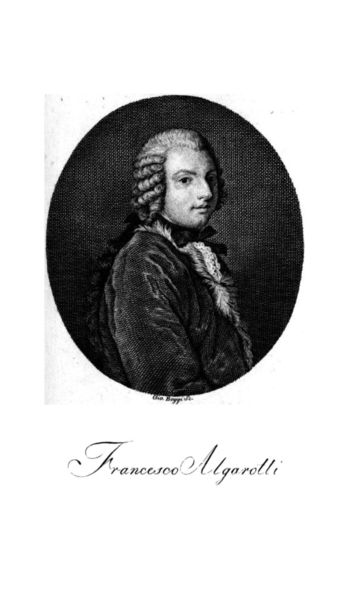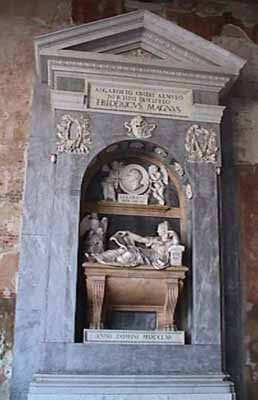<Back to Index>
- Philosopher Francesco Algarotti, 1712
- Writer Alfred Louis Charles de Musset - Pathay, 1810
- Pope Leo X (Giovanni di Lorenzo de' Medici), 1475
PAGE SPONSOR


Count Francesco Algarotti (11 December 1712 – 3 May 1764) was an Italian philosopher and art critic. He also completed engravings.
He was born in Venice to a rich merchant. He studied at Rome for a year, and then Bologna, he studied natural sciences and mathematics. At the age of twenty, he went to Paris, where he became friendly with Voltaire and produced his Neutonianismo per le dame ("Newtonism for Ladies"), a work on optics. Voltaire called him his "cher cygne de Padoue" ("dear swan of Padua"). Two years later he was in London, where he was made a fellow of the Royal Society, and became embroiled in a lively bisexual love triangle with the politician John Hervey, and Lady Mary Wortley Montagu. Algarotti later dedicated six of the letters that made up his Viaggi di Russia to Hervey. Returning from a journey to Russia, he met Frederick the Great, who made him a Prussian count in 1740 and court chamberlain in 1747; they are said to have been lovers. Augustus III of Poland also honored him with the title of councilor. In 1754, after seven years' residence partly in Berlin and partly in Dresden, he returned to Italy, living at Venice and then at Pisa, where he died. Frederick the Great erected to his memory a monument on the Campo Santo at Pisa. He was "one of the first beaux esprits of the age", a man of wide knowledge, a connoisseur in art and music, and the friend of most of the leading authors of his time.
His chief work on art is the Saggi sopra le belle arti ("Essays on the Fine Arts"). Among his other works were Poems, Travels in Russia, Essay on Painting, and Correspondence.
He was one of the main collectors of art for Augustus III of Poland's collection in Dresden. His choice of works reflects the encyclopedic interests of the Neoclassic age; he was uninterested in developing a single unitary stylistic collection, he envisioned a modern museum, a catalog of styles from across the ages. For contemporary commissions, he wrote up a list for paintings he recommended commissioning, including to ask of history paintings from Tiepolo, Pittoni, and Piazzetta; scenes with animals from Castiglione, and veduta with ruins from Pannini. He wanted "suggetti graziosi e leggeri" from Balestra, Boucher, and Donato Creti.